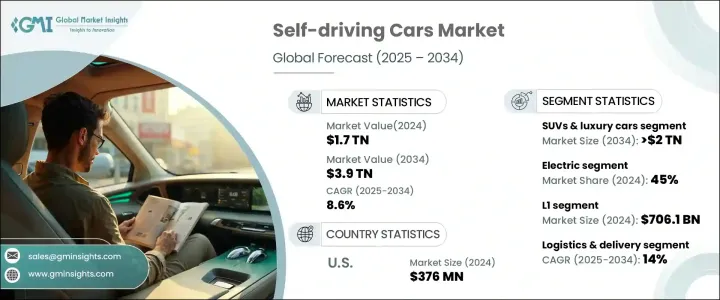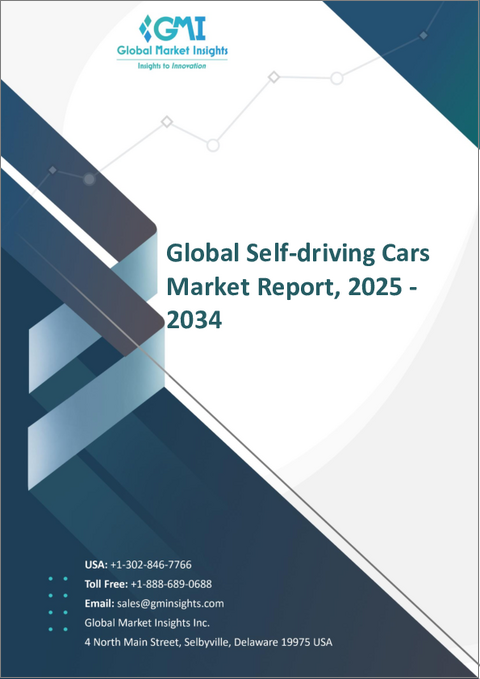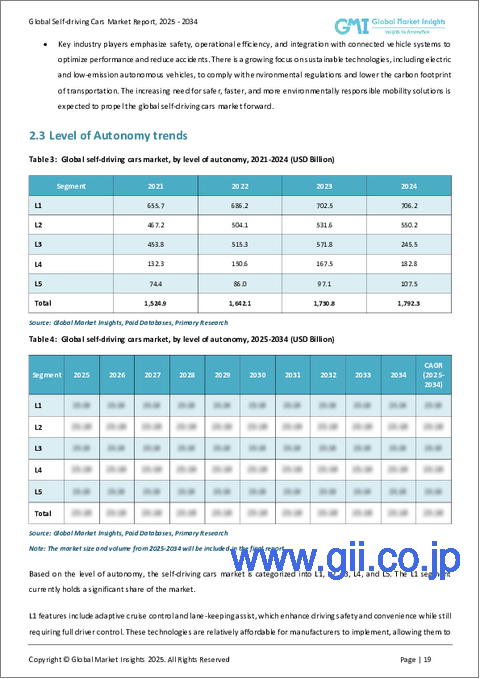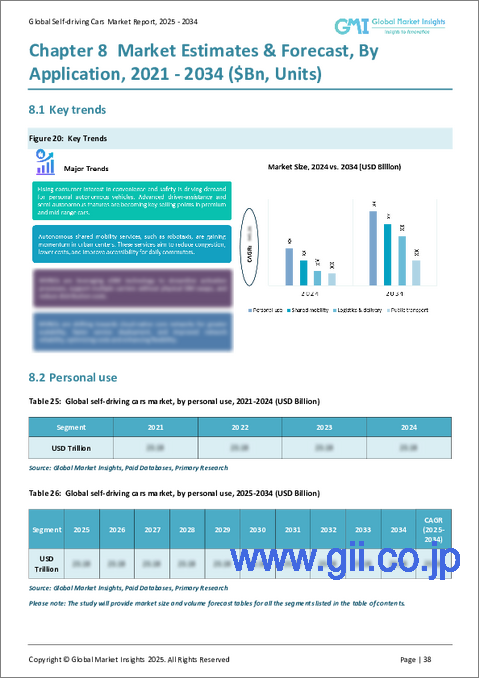|
|
市場調査レポート
商品コード
1698233
自動運転車市場の機会、成長促進要因、産業動向分析、2025年~2034年の予測Self-driving Cars Market Opportunity, Growth Drivers, Industry Trend Analysis, and Forecast 2025-2034 |
||||||
カスタマイズ可能
|
|||||||
| 自動運転車市場の機会、成長促進要因、産業動向分析、2025年~2034年の予測 |
|
出版日: 2025年02月06日
発行: Global Market Insights Inc.
ページ情報: 英文 170 Pages
納期: 2~3営業日
|
全表示
- 概要
- 目次
世界の自動運転車市場は、2024年に1兆7,000億米ドルと評価され、2025年から2034年にかけてCAGR 8.6%で拡大すると予想されています。
この成長を後押ししている主な要因は、世界保健機関(WHO)が報告しているように、世界中で毎年130万人以上の命を奪っている交通事故を大幅に削減できる自律走行車の可能性です。こうした死亡事故の90%以上はヒューマンエラーによるもので、自律走行システムはAI主導の意思決定とADAS(先進運転支援システム)を通じてこれを排除することを目指しています。高度なセンサーの統合により、複雑な都市環境での正確なナビゲーションが可能になる一方、5Gを利用したV2X(Vehicle-to-Everything)通信により、リアルタイムの交通情報と交通安全が確保されます。2050年までに都市人口が大幅に増加すると予測される中、自律走行車はスマートシティインフラの開発において極めて重要な役割を果たし、持続可能で効率的な交通ソリューションを促進しています。

製品タイプ別に見ると、市場にはコンパクトSUV、ミッドサイズSUV、高級SUVが含まれます。SUVと高級モデルは2024年に市場の43%以上を占め、2034年には2兆米ドルを突破すると見られています。広々としたデザインは、快適性を損なうことなく、LiDAR、RADAR、AIベースのソフトウェアといった最先端の自律走行技術を搭載しています。これらの自動車は、高度な安全性とパーソナライズされた運転体験への投資を厭わない、技術に精通したアーリーアダプターにアピールします。さらに、SUVは家族向けやオフロード用として高い機能性を維持しており、自律走行分野での採用をさらに後押ししています。
| 市場範囲 | |
|---|---|
| 開始年 | 2024 |
| 予測年 | 2025-2034 |
| 開始金額 | 1兆7,000億米ドル |
| 予測金額 | 3兆9,000億米ドル |
| CAGR | 8.6% |
推進力に関しては、自動運転車は内燃機関車(ICE)、ハイブリッド車、電気自動車に分類されます。電気自動車は、自律走行システムとのシームレスな統合が主な理由で、2024年には45%の市場シェアを占める。EVは、集中型の電子アーキテクチャと接続機能を備えているため、自律走行機能をサポートする上で当然の優位性を持っています。世界各国の政府は、税制優遇、補助金、充電インフラの拡充を通じてEVの採用を後押しし続けており、次世代の自律走行車両を開発する自動車メーカーにとってEVは好ましい選択肢となっています。
自律走行レベルにはL1からL5まであり、2024年にはL1が7,061億米ドルを占める。アダプティブ・クルーズ・コントロールやレーン・キーピング・アシスタンスなどのL1機能は、ドライバーの監視を維持しながら運転の安全性を高める。これらの技術はコスト効率に優れているため、さまざまな車両セグメントで広く利用できます。自動緊急ブレーキを含む基本的な運転支援機能を義務付ける規制要件の高まりは、L1システムの需要を引き続き促進し、市場での存在感を確実なものにしています。
自律走行車の用途は、個人使用、共有モビリティ、物流、公共輸送に及ぶ。物流・配送分野が予測期間中のCAGRが14%と最も速い成長が見込まれています。個人使用の自律走行車は利便性を高め、乗客が移動中にその他の活動に従事できるようにします。シェアード・モビリティ・サービスは自律走行タクシーを徐々に統合し、都市交通の効率を向上させています。コストの低下と経済的アクセシビリティの向上により、自動運転車の個人所有はより広まりつつあります。
自動運転車市場は北米が25%のシェアを占め、米国は2024年に3,760億米ドルの収益を上げます。同地域は自律走行車の技術革新でリードしており、ハイテク企業がAI、センサー技術、コネクティビティの進歩を開拓しています。有利な政府規制と継続的な政策支援が市場拡大をさらに加速させ、自動運転技術の世界的リーダーとしての北米の地位を確固たるものにしています。
目次
第1章 調査手法と調査範囲
- 調査デザイン
- 調査アプローチ
- データ収集方法
- 基本推定と計算
- 基準年の算出
- 市場推計の主要動向
- 予測モデル
- 1次調査と検証
- 市場スコープと定義
第2章 エグゼクティブサマリー
第3章 業界洞察
- エコシステム分析
- サプライヤーの状況
- 原材料サプライヤー
- 部品サプライヤー
- メーカー
- 技術プロバイダー
- 最終用途
- 利益率分析
- サプライヤーの状況
- 技術とイノベーションの展望
- 特許分析
- 規制状況
- 価格動向
- 影響要因
- 促進要因
- 人工知能とセンサーの技術的進歩
- 安全機能強化の需要
- シェアードモビリティとライドヘイリングサービスの需要増加
- eコマースと自律配送の需要の高まり
- 環境意識の高まりと持続可能性への注目
- 業界の潜在的リスク&課題
- 規制と法的ハードル
- 高い開発コスト
- 促進要因
- 成長可能性分析
- ポーター分析
- PESTEL分析
第4章 競合情勢
- イントロダクション
- 企業シェア分析
- 競合のポジショニング・マトリックス
- 戦略展望マトリックス
第5章 市場推計・予測:自動化レベル別、2021年~2034年
- 主要動向
- L1
- L2
- L3
- L4
- L5
第6章 市場推計・予測:自動車別、2021年~2034年
- 主要動向
- コンパクトカー
- 中型車
- SUVと高級車
第7章 市場推計・予測:推進別、2021年~2034年
- 主要動向
- ICE
- 電気自動車
- ハイブリッド車
第8章 市場推計・予測:用途別、2021年~2034年
- 主要動向
- パーソナルユース
- シェアードモビリティ
- 物流・配送
- 公共輸送
第9章 市場推計・予測:地域別、2021年~2034年
- 主要動向
- 北米
- 米国
- カナダ
- 欧州
- 英国
- ドイツ
- フランス
- イタリア
- スペイン
- ロシア
- 北欧
- アジア太平洋
- 中国
- インド
- 日本
- オーストラリア
- 韓国
- 東南アジア
- ラテンアメリカ
- ブラジル
- メキシコ
- アルゼンチン
- 中東・アフリカ
- UAE
- 南アフリカ
- サウジアラビア
第10章 企業プロファイル
- Audi(Volkswagen Group)
- BMW
- BYD(Build Your Dreams)
- Cruise(General Motors)
- Ford Motor Company
- Honda
- Hyundai Motor Group
- Lucid Motors
- Mercedes-Benz(Daimler AG)
- Motional Inc
- Navya
- Nissan
- Stellantis
- Tesla
- Toyota
- Volkswagen
- Volvo Cars
- Waymo(Alphabet Inc.)
- Waymo LLC
- Zoox
The Global Self-Driving Cars Market, valued at USD 1.7 trillion in 2024, is expected to expand at a CAGR of 8.6% from 2025 to 2034. The primary factor fueling this growth is the potential of autonomous vehicles to drastically reduce road accidents, which claim over 1.3 million lives worldwide each year, as reported by the World Health Organization. More than 90% of these fatalities result from human error, which autonomous systems aim to eliminate through AI-driven decision-making and advanced driver-assistance technologies. The integration of sophisticated sensors allows precise navigation in complex urban environments, while 5G-powered vehicle-to-everything (V2X) communication ensures real-time traffic updates and road safety. With urban populations projected to rise significantly by 2050, autonomous vehicles are playing a pivotal role in the development of smart city infrastructure, promoting sustainable and efficient transportation solutions.

By product type, the market includes compact, mid-size, and luxury SUVs. SUVs and luxury models captured over 43% of the market in 2024 and are set to surpass USD 2 trillion by 2034. Their spacious design accommodates cutting-edge autonomous technology such as LiDAR, RADAR, and AI-based software without compromising comfort. These vehicles appeal to tech-savvy early adopters willing to invest in advanced safety and personalized driving experiences. Additionally, SUVs remain highly functional for family and off-road use, further boosting their adoption within the autonomous sector.
| Market Scope | |
|---|---|
| Start Year | 2024 |
| Forecast Year | 2025-2034 |
| Start Value | $1.7 Trillion |
| Forecast Value | $3.9 Trillion |
| CAGR | 8.6% |
In terms of propulsion, self-driving vehicles are classified into internal combustion engine (ICE), hybrid, and electric models. Electric vehicles held a 45% market share in 2024, largely due to their seamless integration with autonomous systems. EVs have a natural advantage in supporting autonomous driving features, given their centralized electronic architecture and connectivity capabilities. Governments worldwide continue to push EV adoption through tax benefits, subsidies and expanded charging infrastructure, making them a preferred choice for automakers developing next-generation autonomous fleets.
Autonomy levels range from L1 to L5, with L1 accounting for USD 706.1 billion in 2024. L1 features, such as adaptive cruise control and lane-keeping assistance, enhance driving safety while maintaining driver oversight. These technologies are cost-effective to implement, making them widely available across various vehicle segments. Growing regulatory requirements mandating basic driver-assistance features, including automatic emergency braking, continue to drive demand for L1 systems, ensuring their strong market presence.
Autonomous vehicle applications span personal use, shared mobility, logistics, and public transport. The logistics and delivery sector is expected to witness the fastest growth, with a 14% CAGR during the forecast period. Personal-use autonomous vehicles provide enhanced convenience, enabling passengers to engage in other activities while traveling. Shared mobility services are gradually integrating autonomous taxis, improving urban transportation efficiency. With declining costs and increasing financial accessibility, personal ownership of self-driving cars is becoming more widespread.
North America dominates the self-driving cars market, holding a 25% share, with the United States generating USD 376 billion in revenue in 2024. The region leads in autonomous vehicle innovation, with tech firms pioneering advancements in AI, sensor technology, and connectivity. Favorable government regulations and ongoing policy support further accelerate market expansion, solidifying North America's position as a global leader in self-driving technology.
Table of Contents
Chapter 1 Methodology & Scope
- 1.1 Research design
- 1.1.1 Research approach
- 1.1.2 Data collection methods
- 1.2 Base estimates & calculations
- 1.2.1 Base year calculation
- 1.2.2 Key trends for market estimation
- 1.3 Forecast model
- 1.4 Primary research and validation
- 1.4.1 Primary sources
- 1.4.2 Data mining sources
- 1.5 Market scope & definition
Chapter 2 Executive Summary
- 2.1 Industry 3600 synopsis, 2021 - 2034
Chapter 3 Industry Insights
- 3.1 Industry ecosystem analysis
- 3.1.1 Supplier landscape
- 3.1.1.1 Raw material suppliers
- 3.1.1.2 Component suppliers
- 3.1.1.3 Manufacturers
- 3.1.1.4 Technology providers
- 3.1.1.5 End use
- 3.1.2 Profit margin analysis
- 3.1.1 Supplier landscape
- 3.2 Technology & innovation landscape
- 3.3 Patent analysis
- 3.4 Regulatory landscape
- 3.5 Price trend
- 3.6 Impact forces
- 3.6.1 Growth drivers
- 3.6.1.1 Technological advancements in artificial intelligence and sensors
- 3.6.1.2 Demand for enhanced safety features
- 3.6.1.3 Increasing demand for shared mobility and ride-hailing services
- 3.6.1.4 Rising e-commerce and demand for autonomous delivery
- 3.6.1.5 Growing environmental awareness and focus on sustainability
- 3.6.2 Industry pitfalls & challenges
- 3.6.2.1 Regulatory and legal hurdles
- 3.6.2.2 High development costs
- 3.6.1 Growth drivers
- 3.7 Growth potential analysis
- 3.8 Porter's analysis
- 3.9 PESTEL analysis
Chapter 4 Competitive Landscape, 2024
- 4.1 Introduction
- 4.2 Company market share analysis
- 4.3 Competitive positioning matrix
- 4.4 Strategic outlook matrix
Chapter 5 Market Estimates & Forecast, By Level of Autonomy, 2021 - 2034 ($Bn, Units)
- 5.1 Key trends
- 5.2 L1
- 5.3 L2
- 5.4 L3
- 5.5 L4
- 5.6 L5
Chapter 6 Market Estimates & Forecast, By Vehicle, 2021 - 2034 ($Bn, Units)
- 6.1 Key trends
- 6.2 Compact cars
- 6.3 Mid-size cars
- 6.4 SUVs & luxury cars
Chapter 7 Market Estimates & Forecast, By Propulsion, 2021 - 2034 ($Bn, Units)
- 7.1 Key trends
- 7.2 ICE
- 7.3 Electric
- 7.4 Hybrid Vehicle
Chapter 8 Market Estimates & Forecast, By Application, 2021 - 2034 ($Bn, Units)
- 8.1 Key trends
- 8.2 Personal use
- 8.3 Shared mobility
- 8.4 Logistics & delivery
- 8.5 Public transport
Chapter 9 Market Estimates & Forecast, By Region, 2021 - 2034 ($Bn, Units)
- 9.1 Key trends
- 9.2 North America
- 9.2.1 U.S.
- 9.2.2 Canada
- 9.3 Europe
- 9.3.1 UK
- 9.3.2 Germany
- 9.3.3 France
- 9.3.4 Italy
- 9.3.5 Spain
- 9.3.6 Russia
- 9.3.7 Nordics
- 9.4 Asia Pacific
- 9.4.1 China
- 9.4.2 India
- 9.4.3 Japan
- 9.4.4 Australia
- 9.4.5 South Korea
- 9.4.6 Southeast Asia
- 9.5 Latin America
- 9.5.1 Brazil
- 9.5.2 Mexico
- 9.5.3 Argentina
- 9.6 MEA
- 9.6.1 UAE
- 9.6.2 South Africa
- 9.6.3 Saudi Arabia
Chapter 10 Company Profiles
- 10.1 Audi (Volkswagen Group)
- 10.2 BMW
- 10.3 BYD (Build Your Dreams)
- 10.4 Cruise (General Motors)
- 10.5 Ford Motor Company
- 10.6 Honda
- 10.7 Hyundai Motor Group
- 10.8 Lucid Motors
- 10.9 Mercedes-Benz (Daimler AG)
- 10.10 Motional Inc
- 10.11 Navya
- 10.12 Nissan
- 10.13 Stellantis
- 10.14 Tesla
- 10.15 Toyota
- 10.16 Volkswagen
- 10.17 Volvo Cars
- 10.18 Waymo (Alphabet Inc.)
- 10.19 Waymo LLC
- 10.20 Zoox






